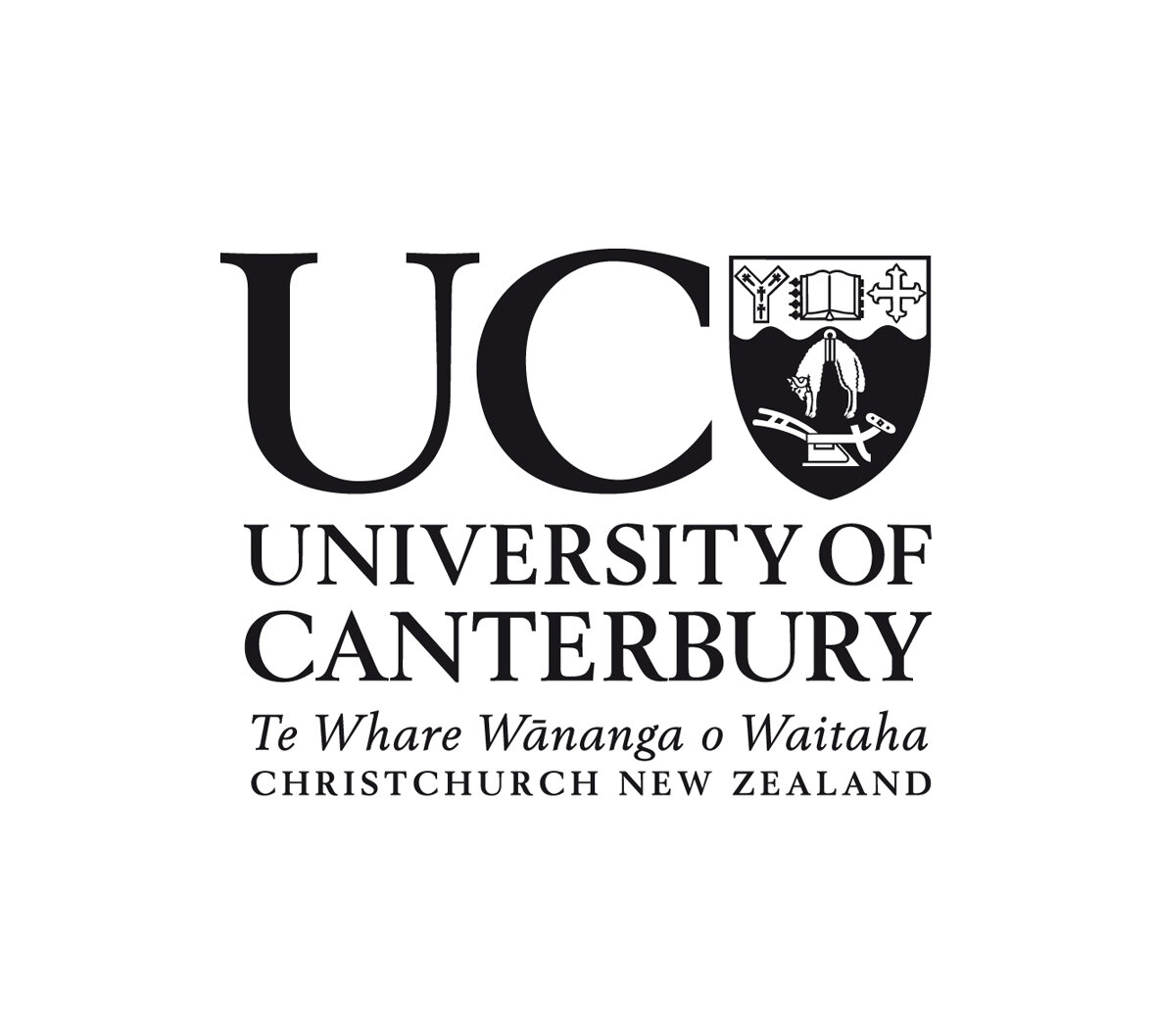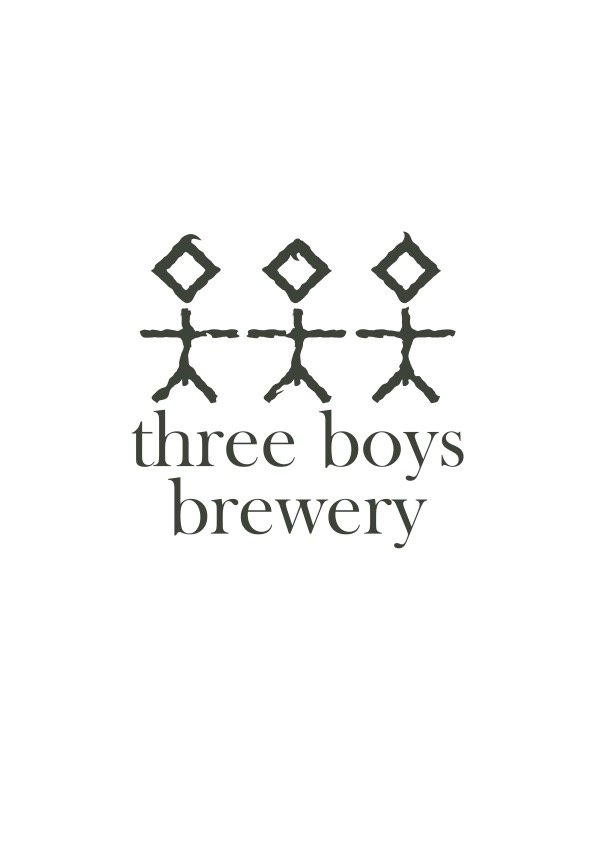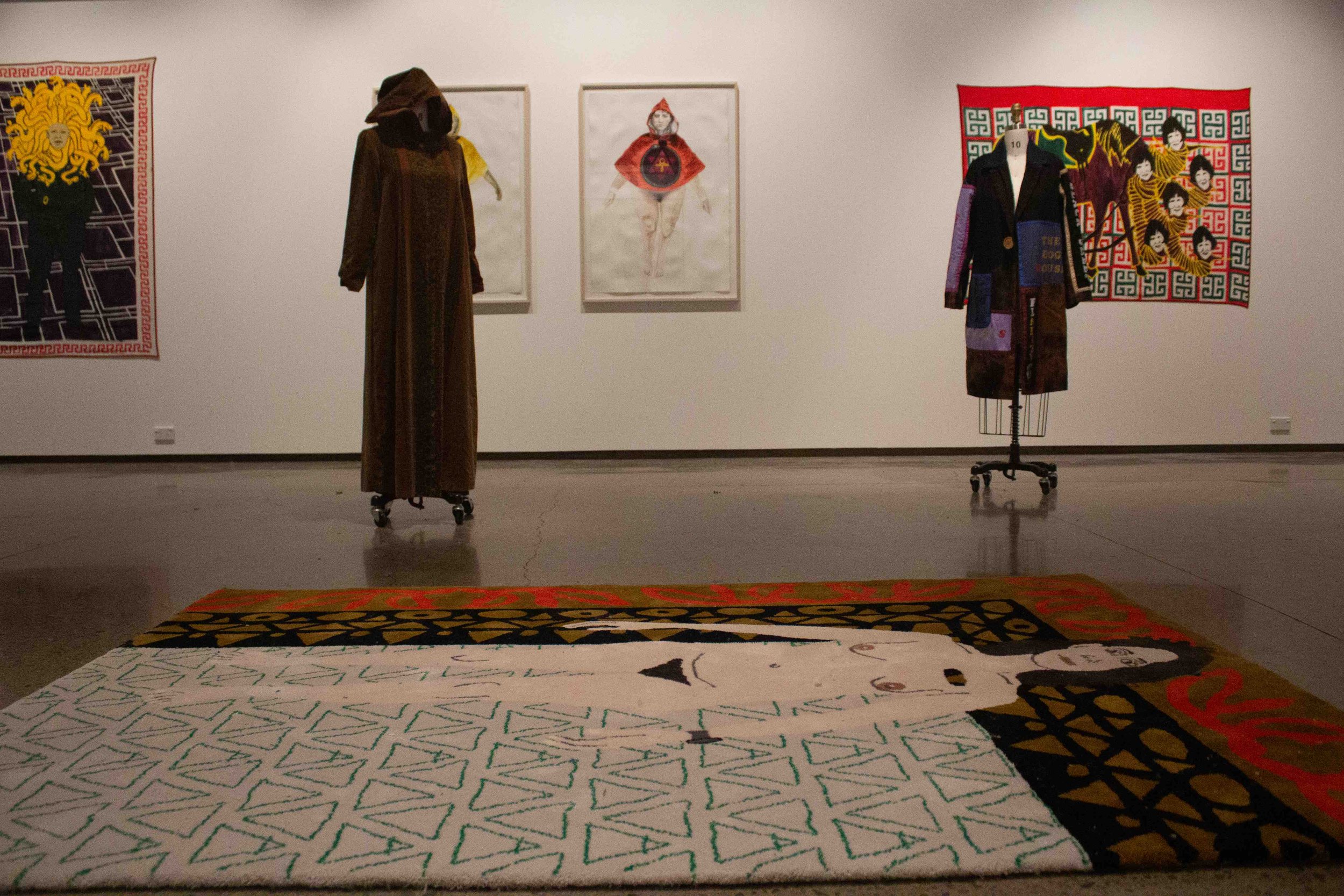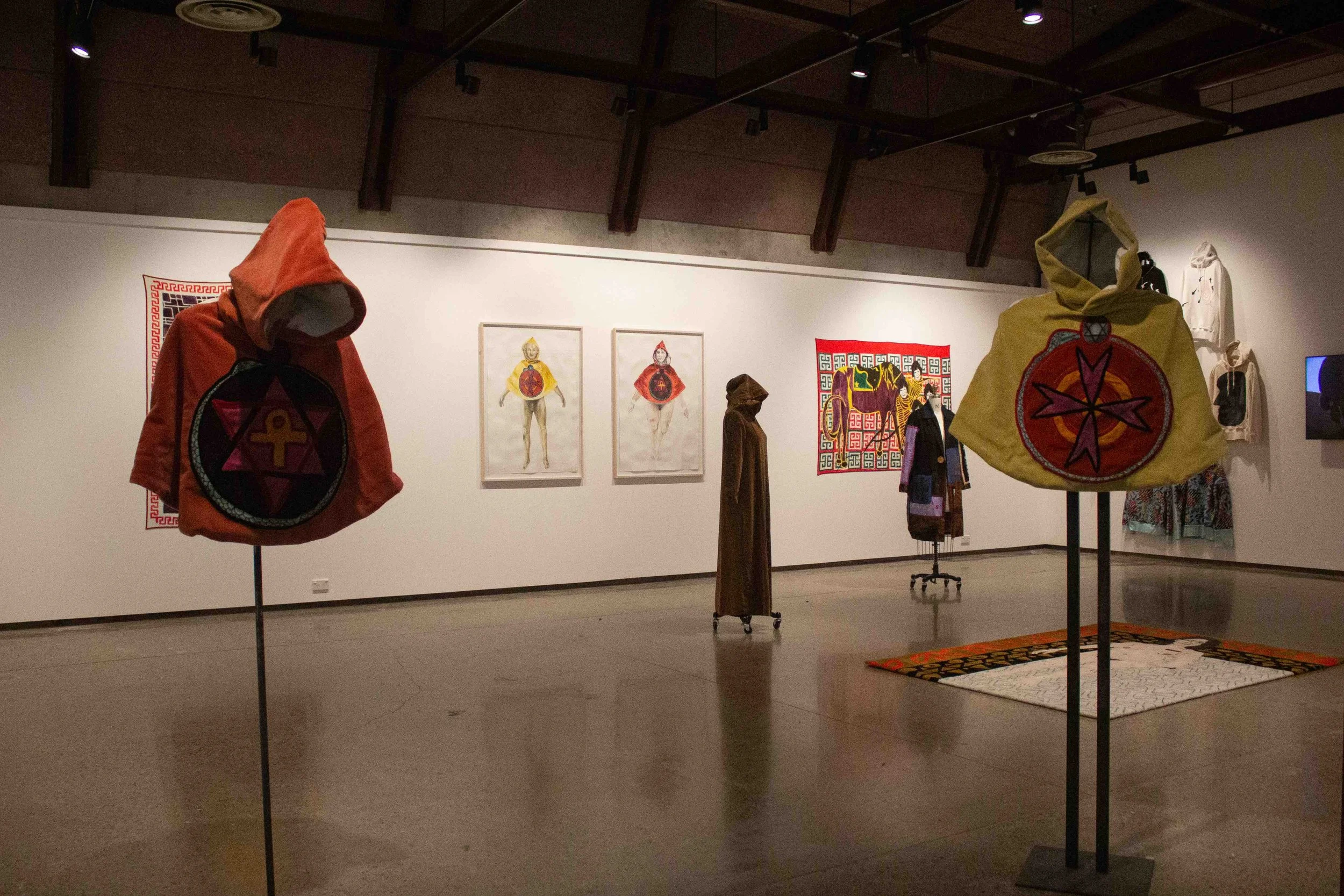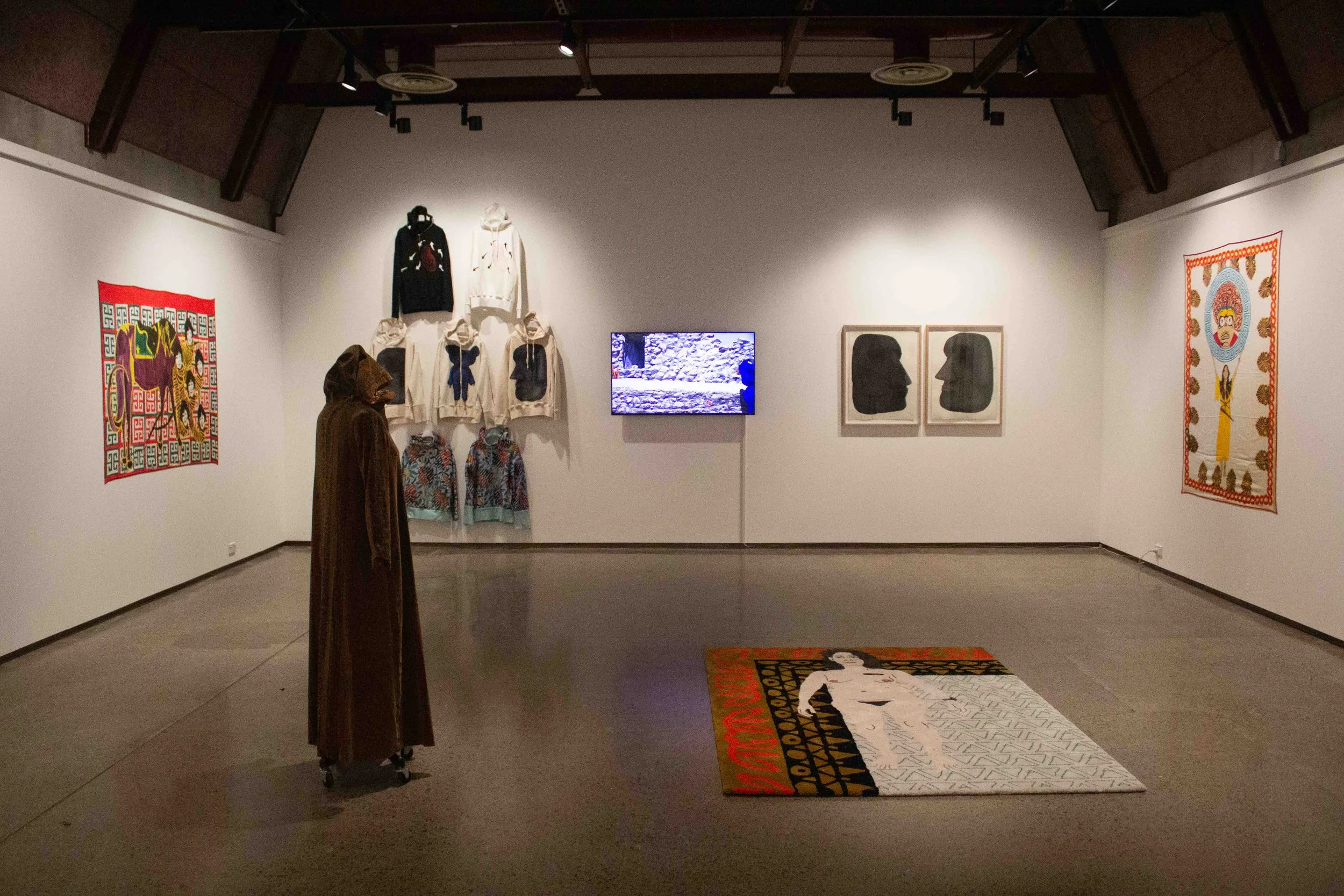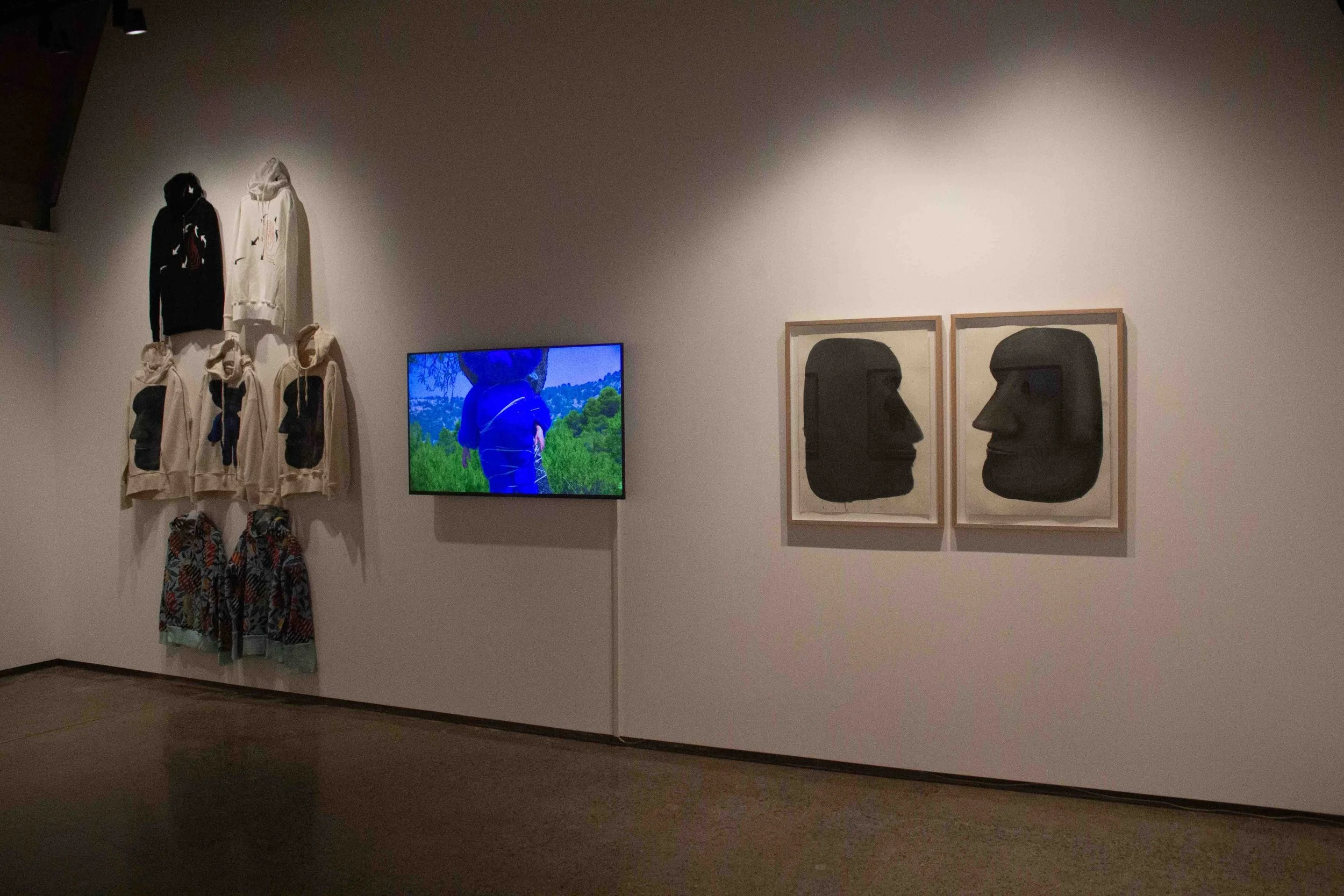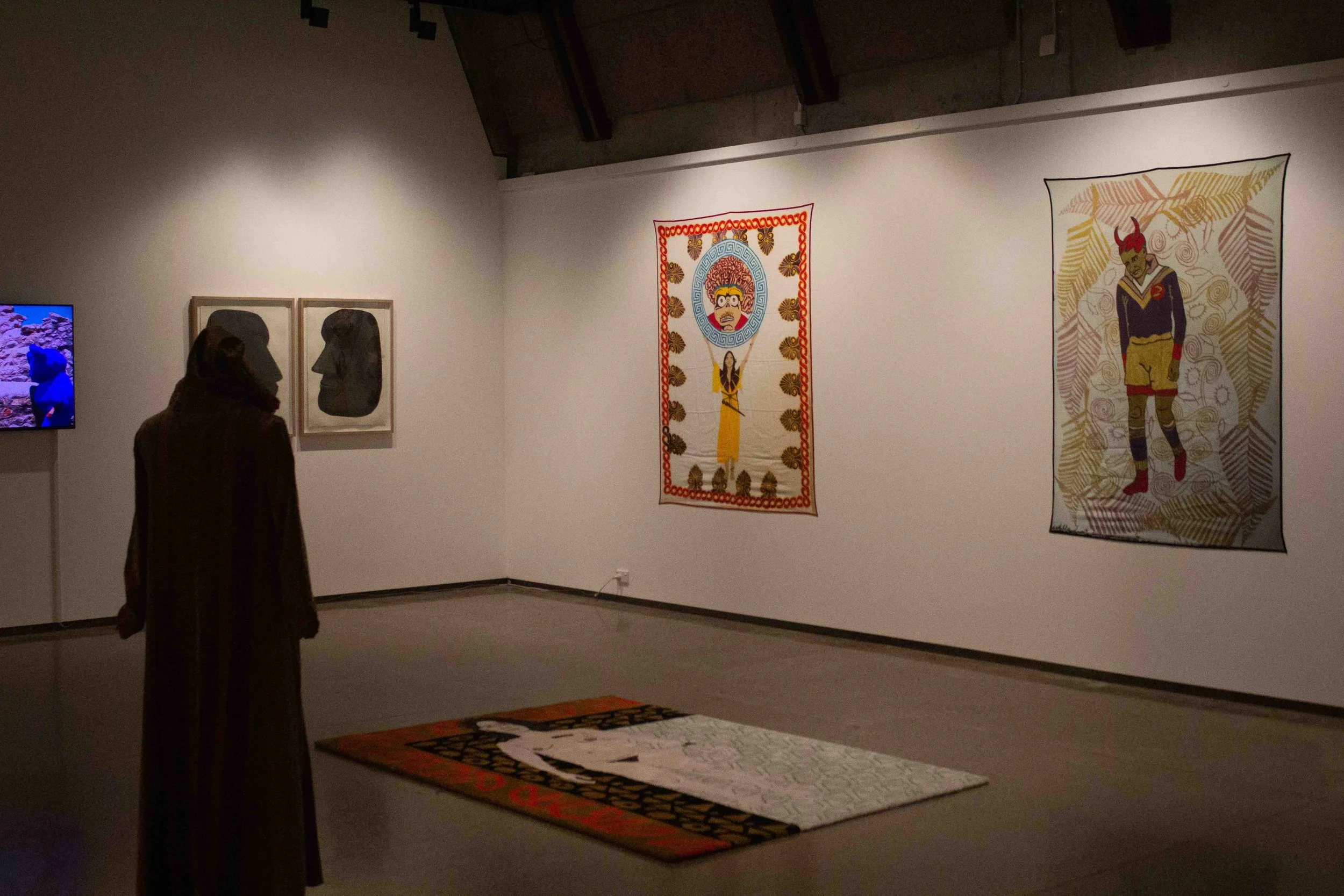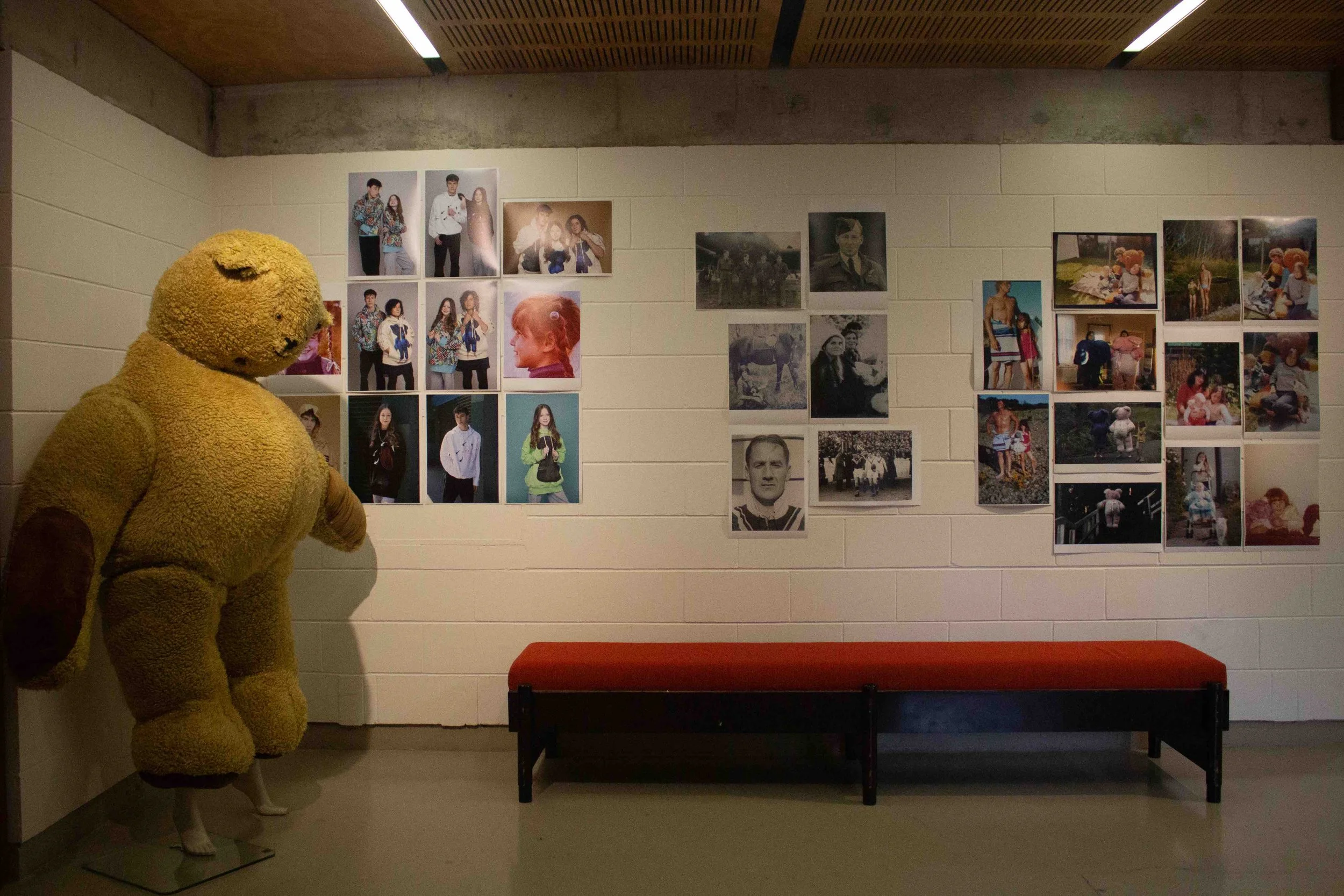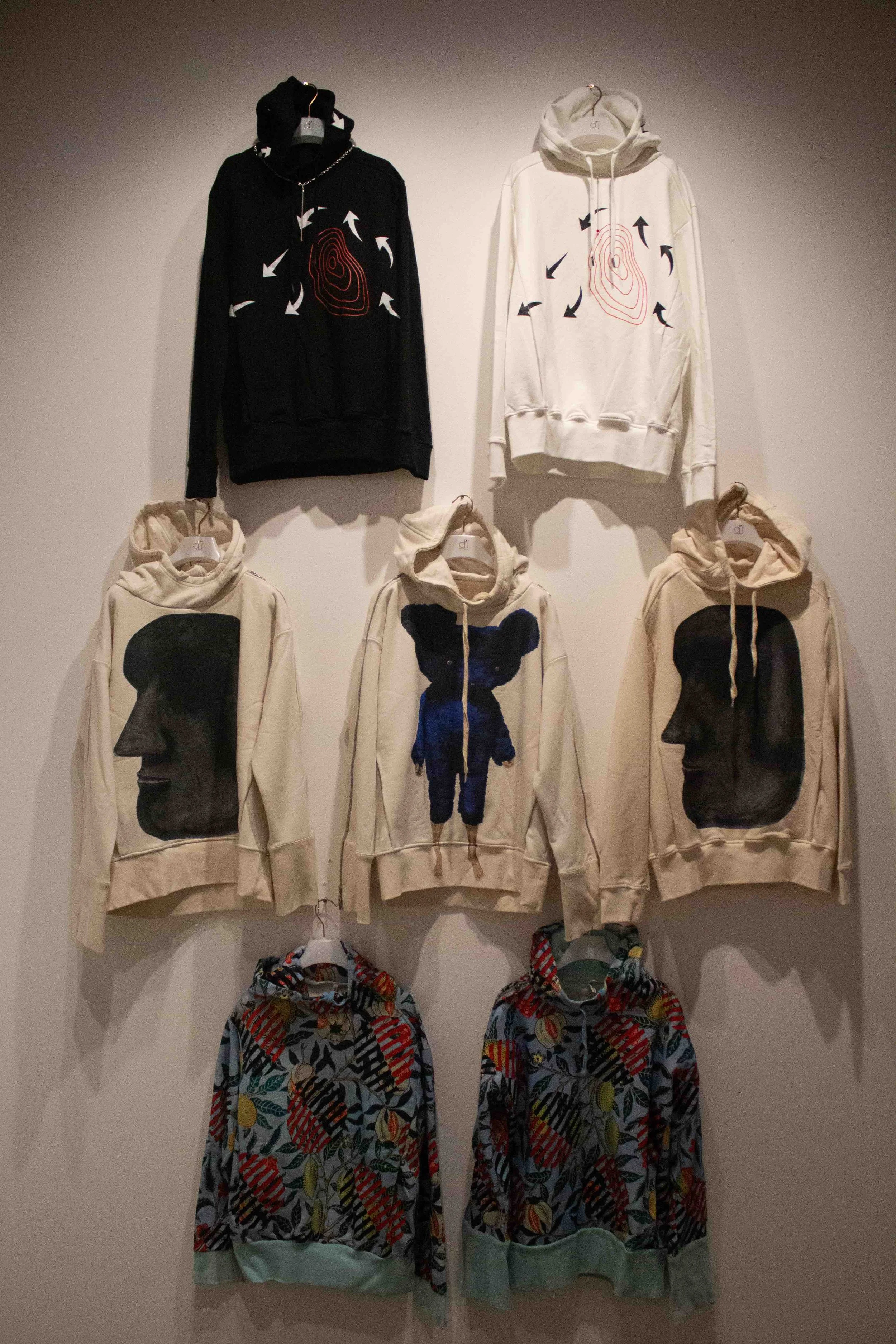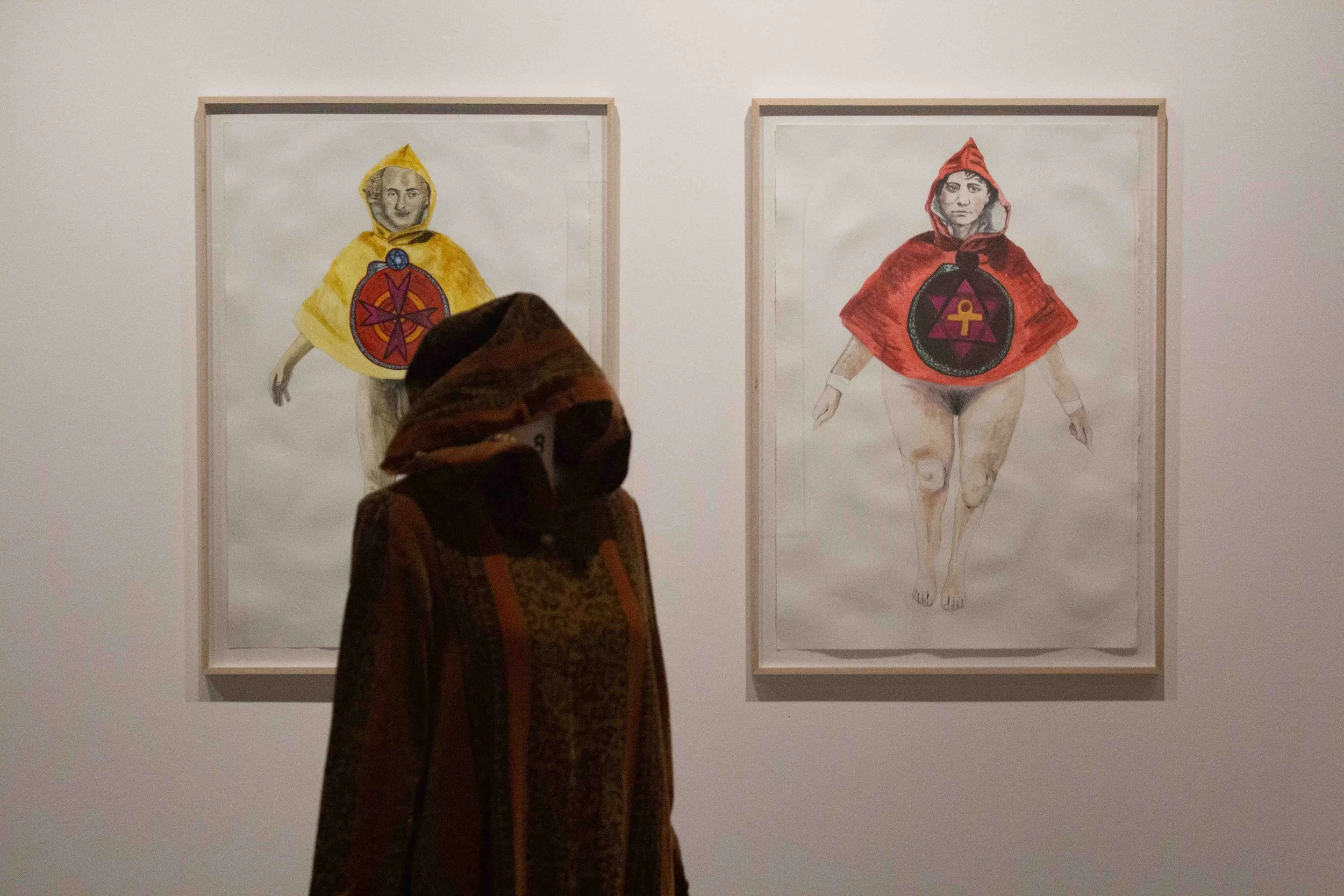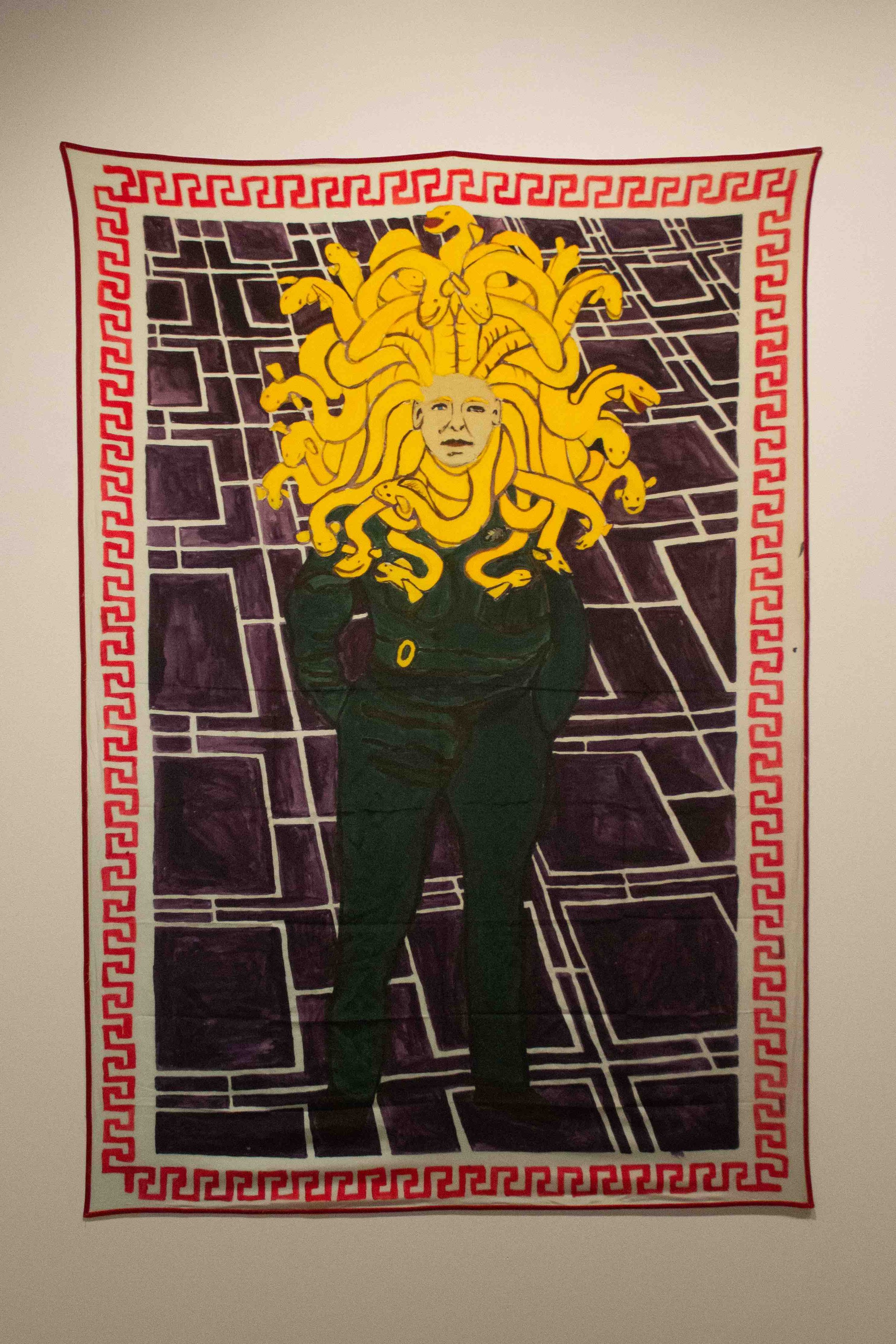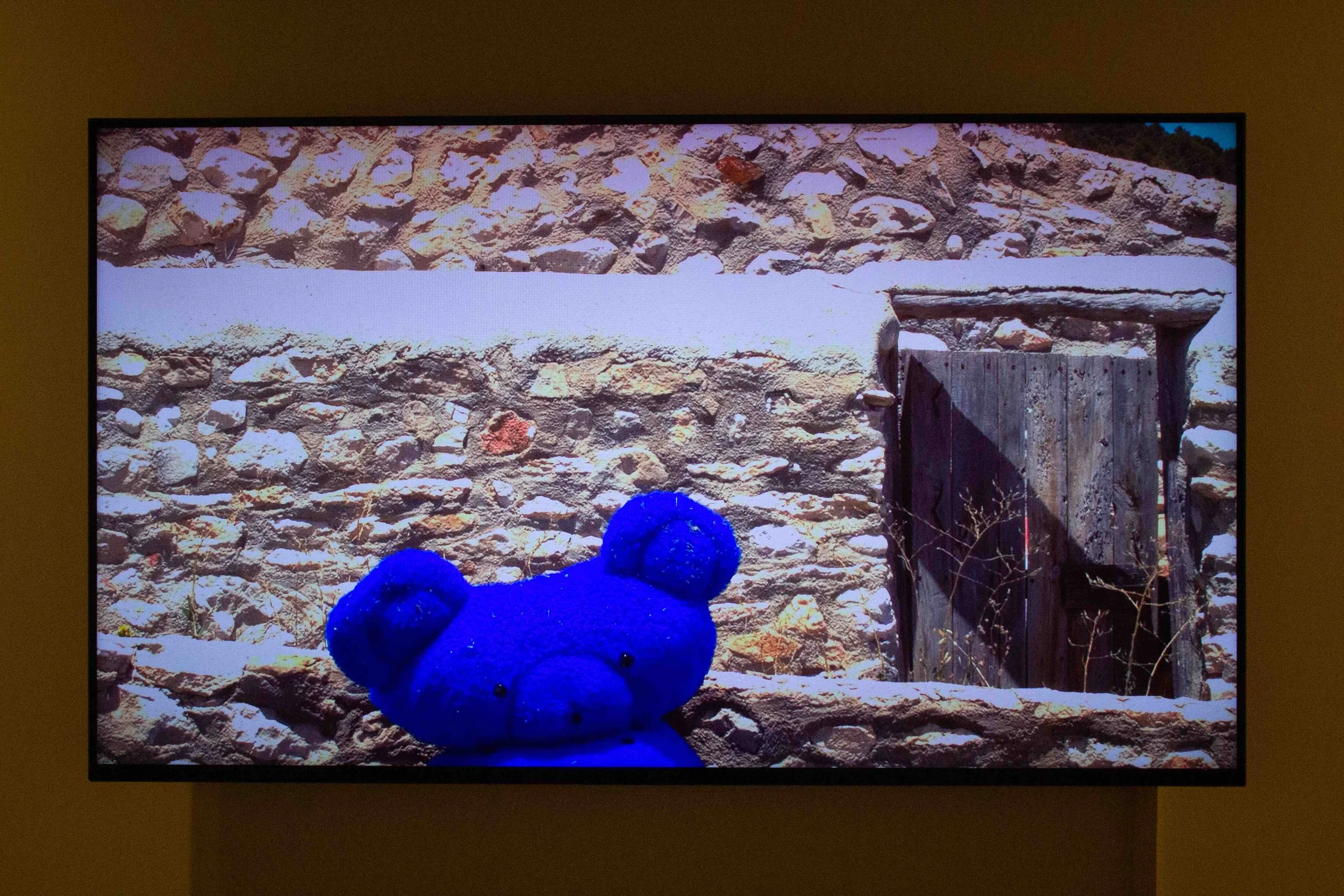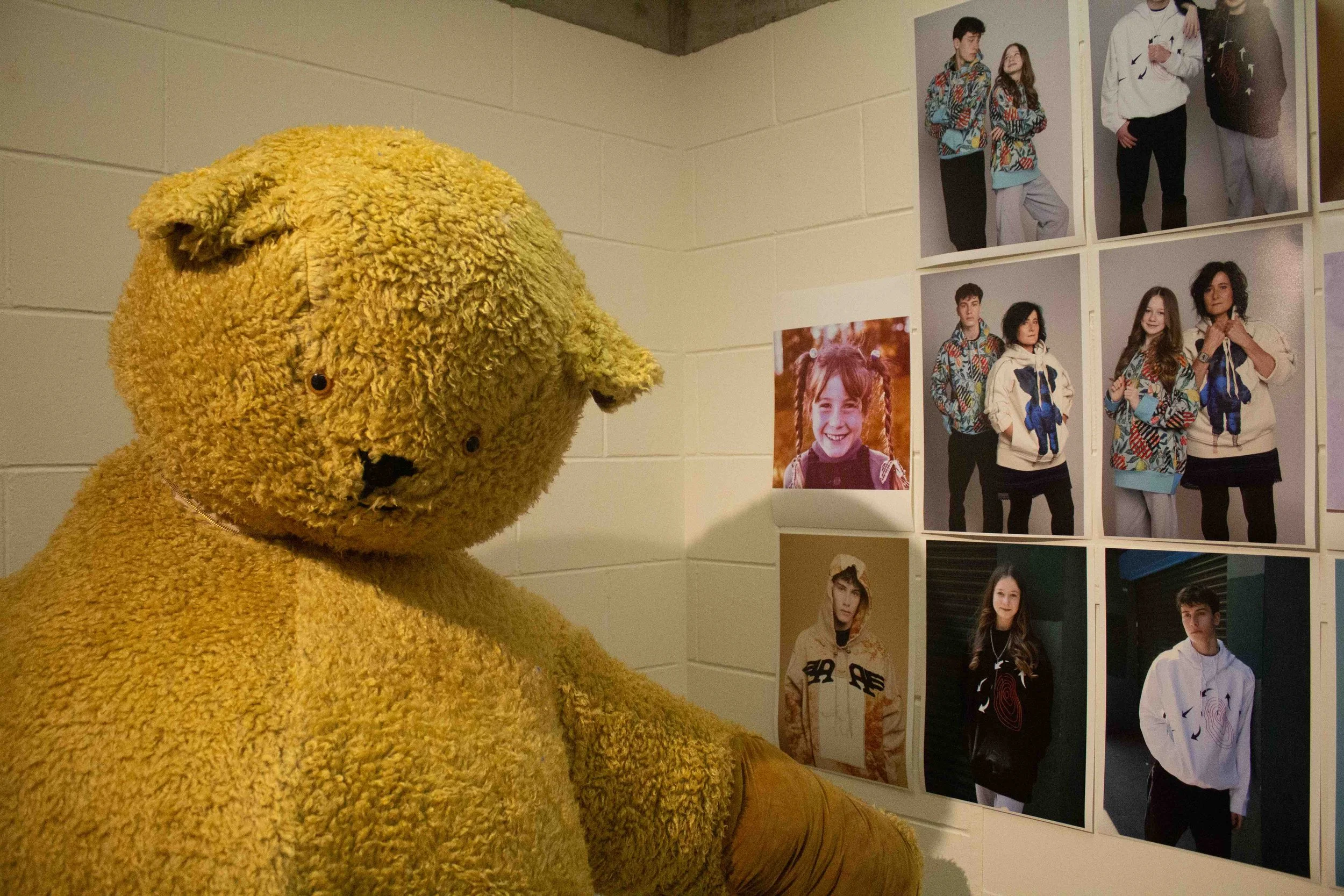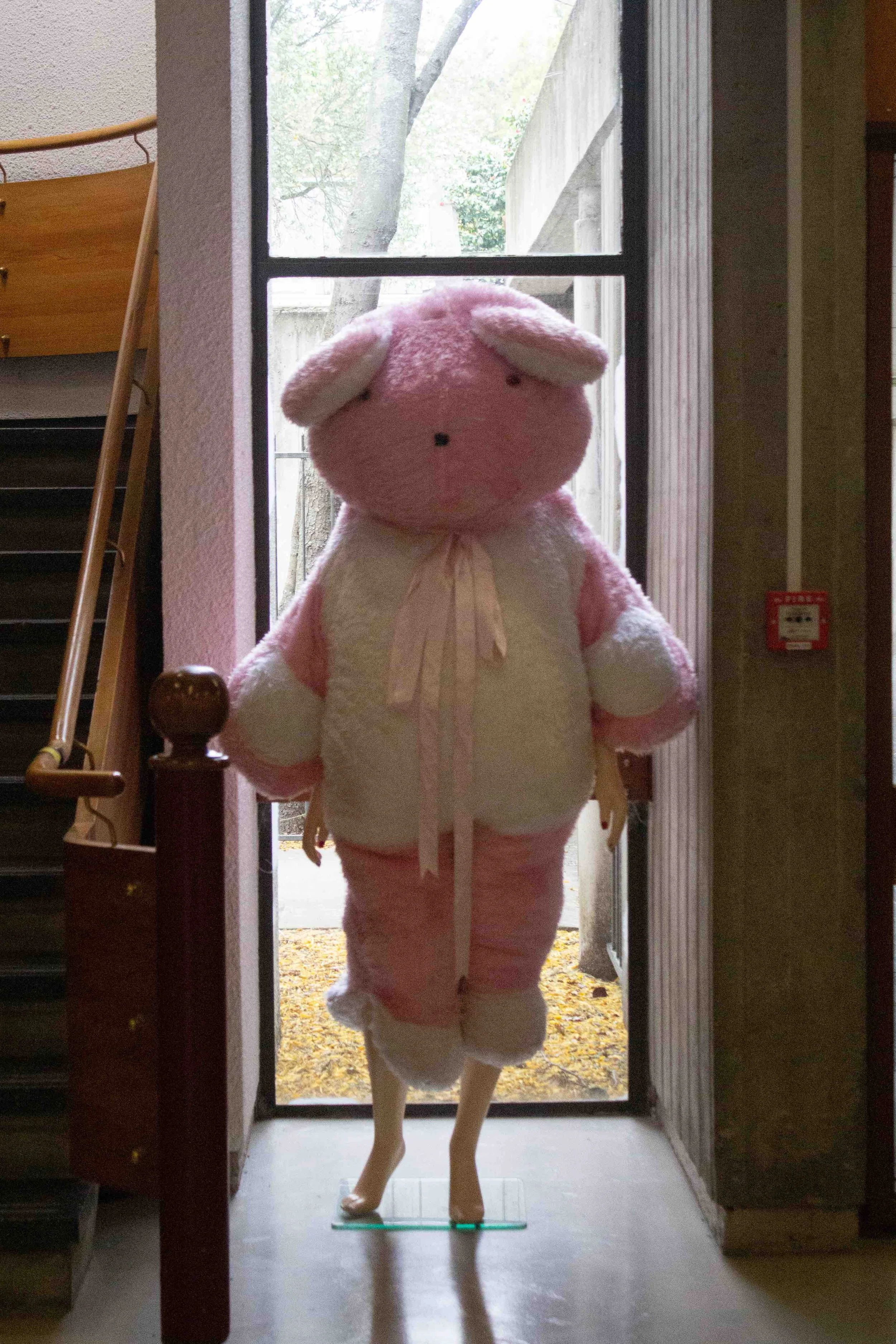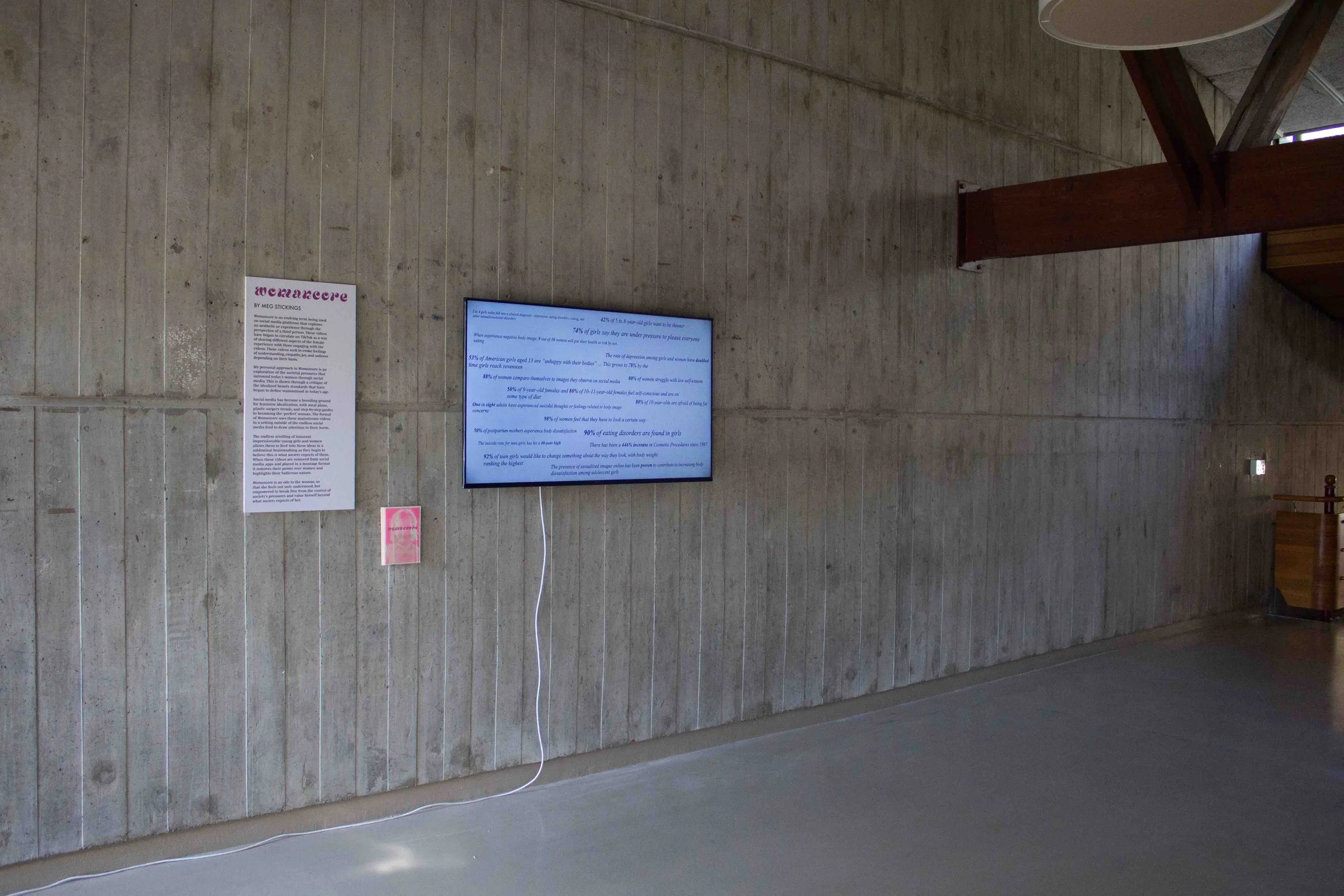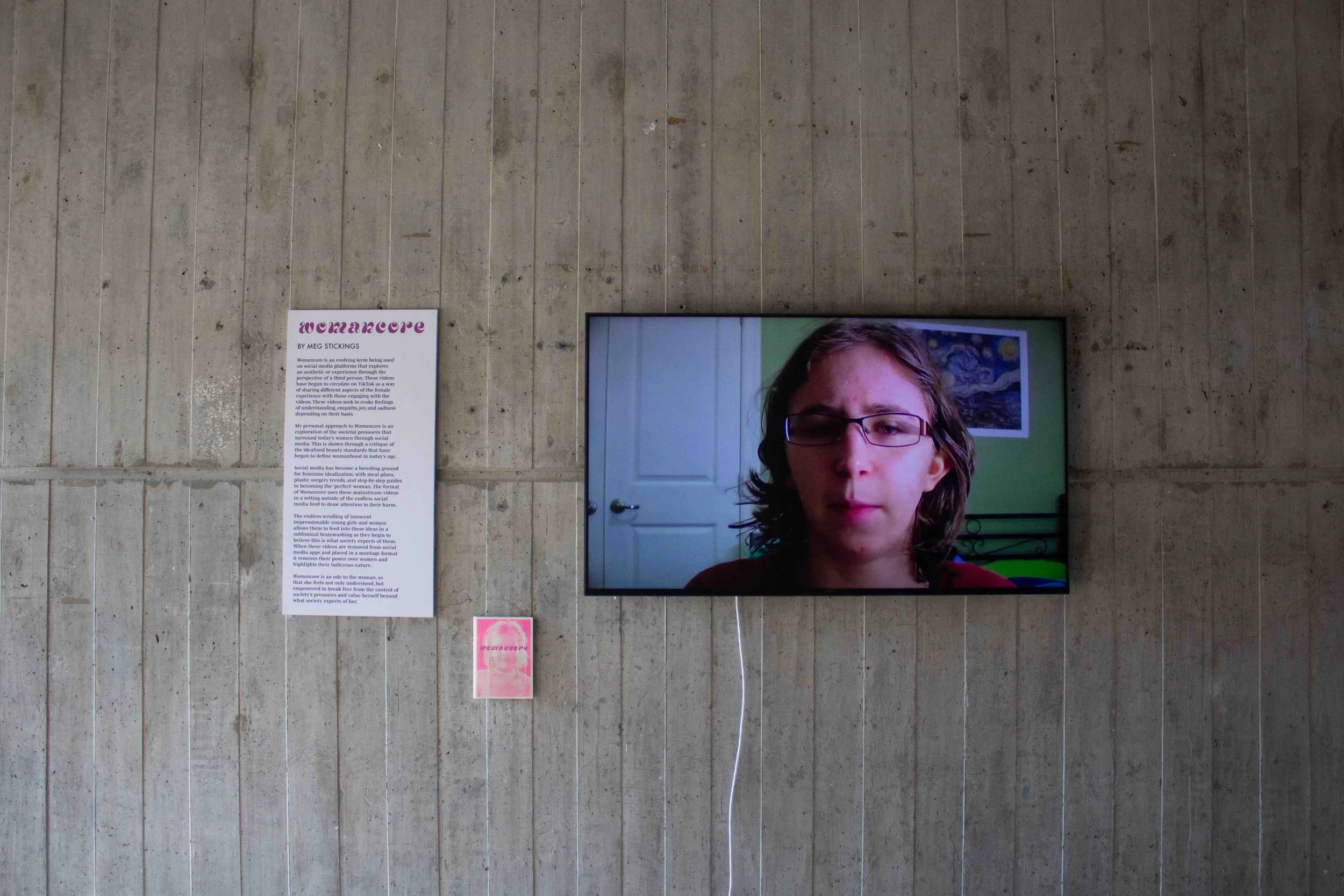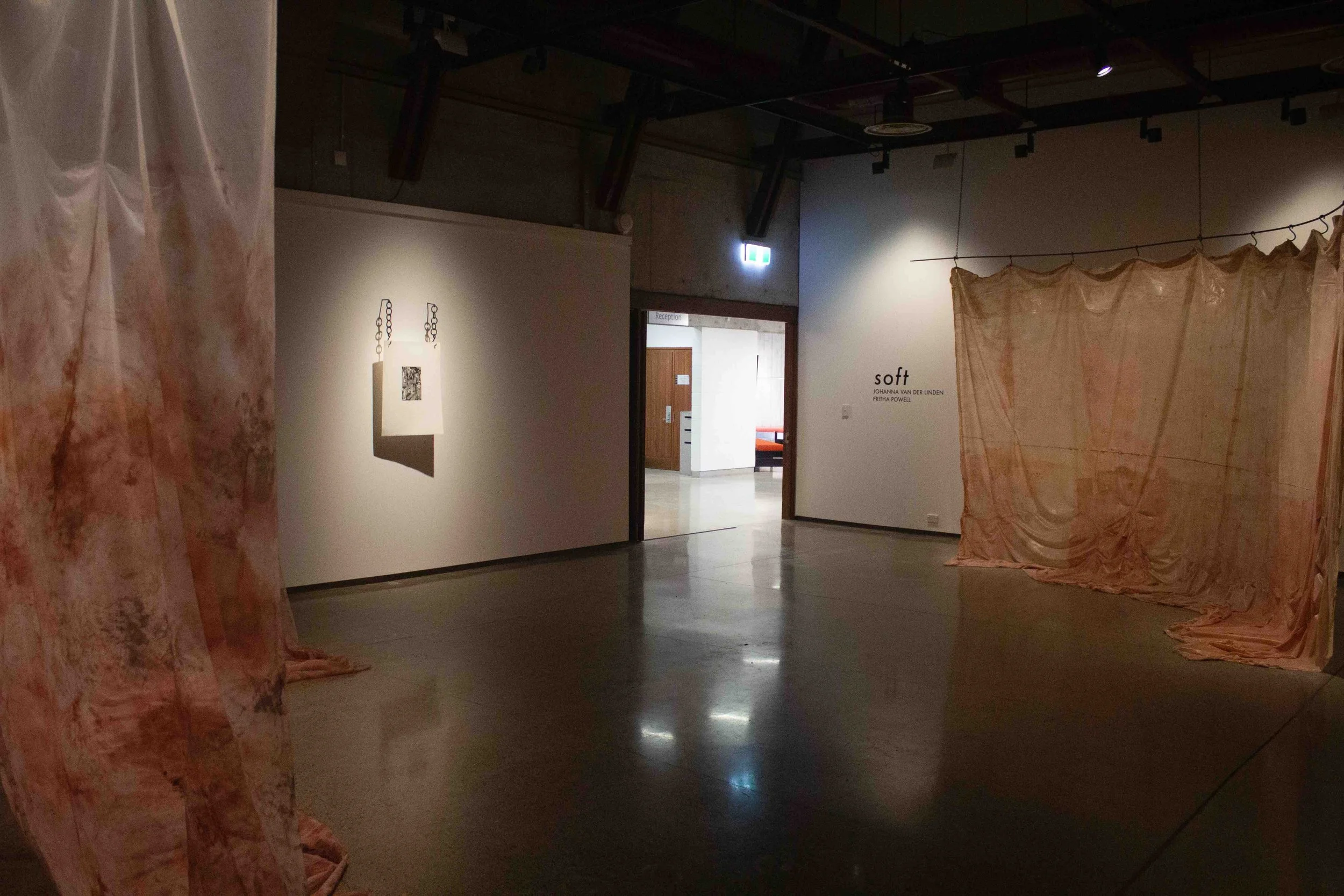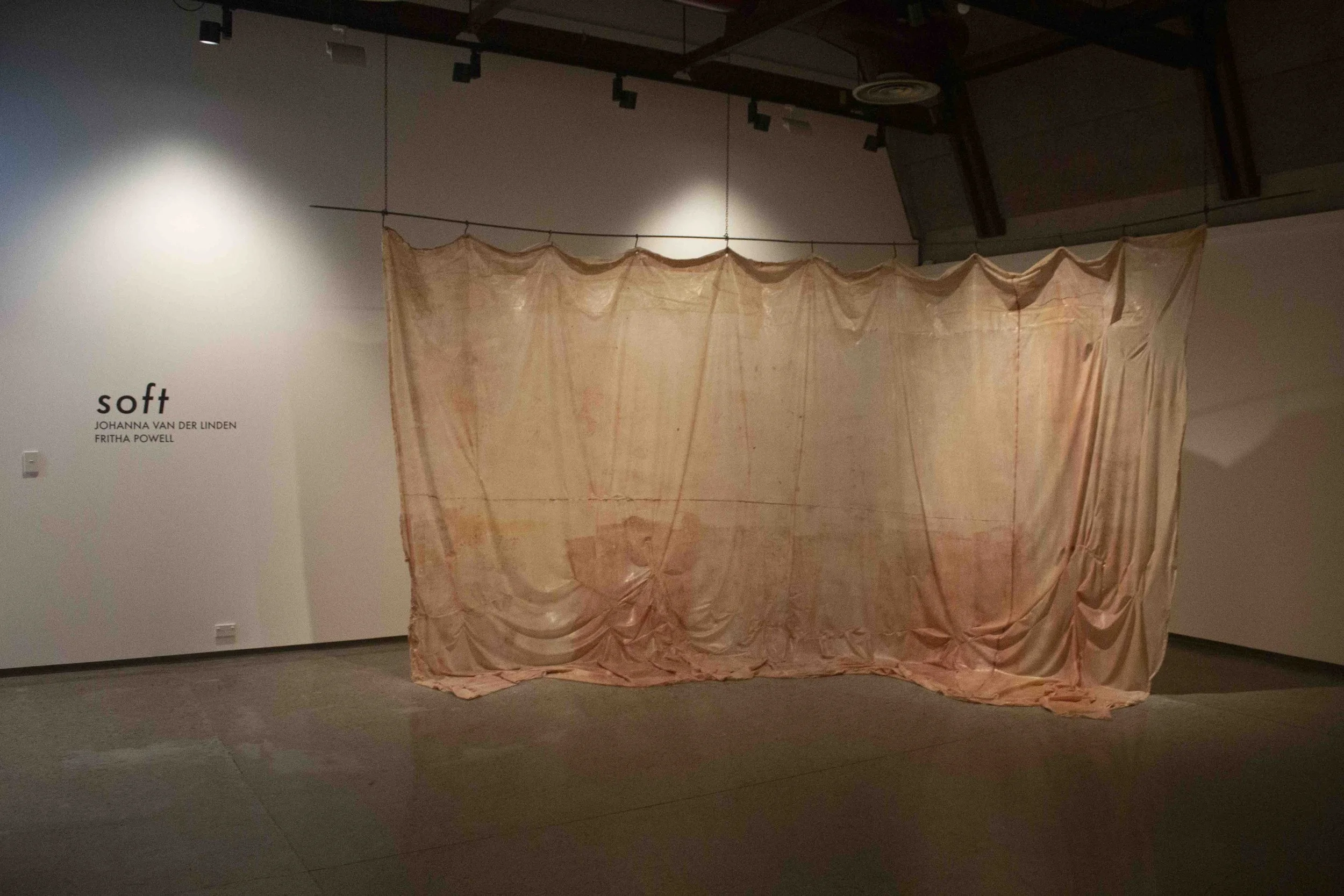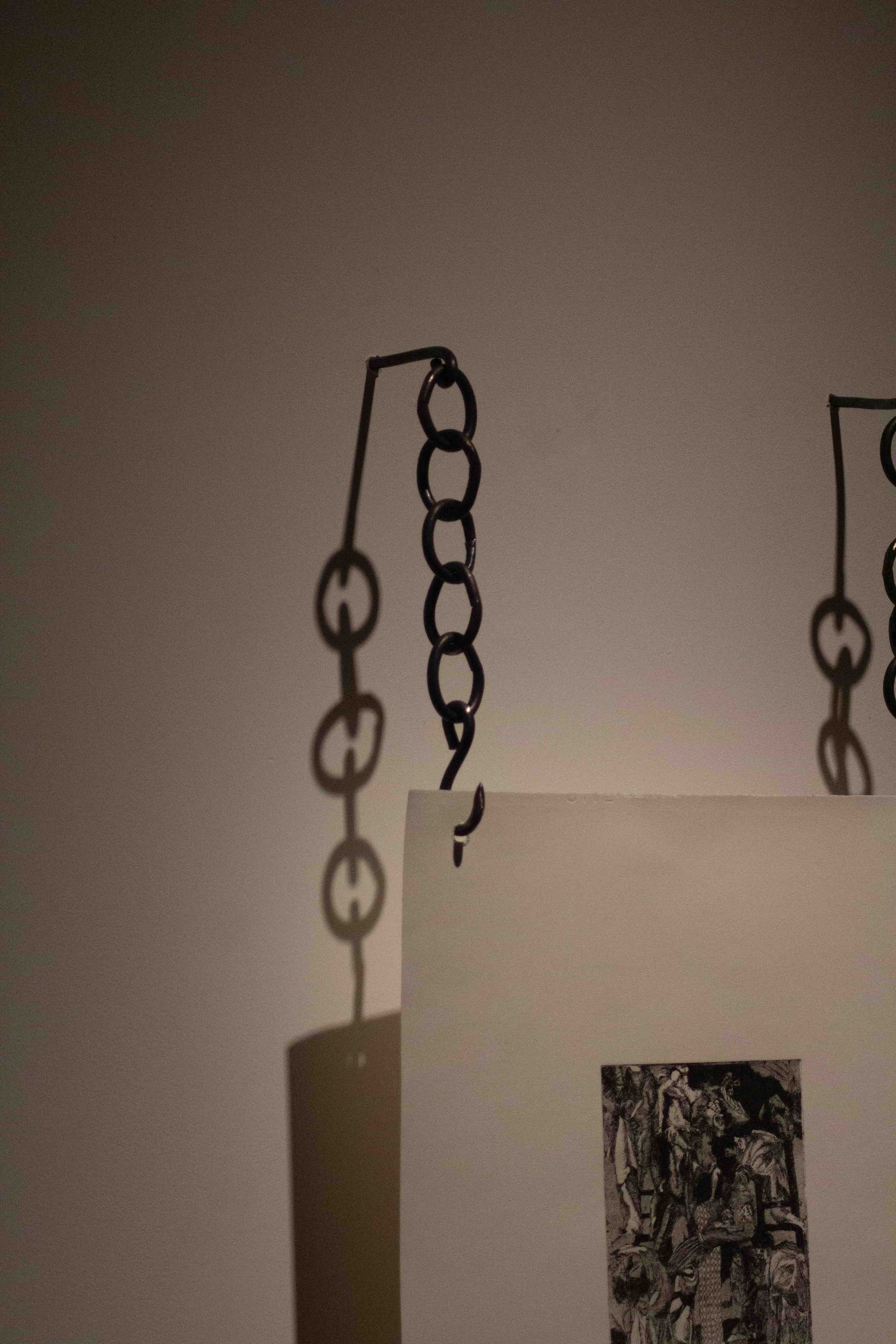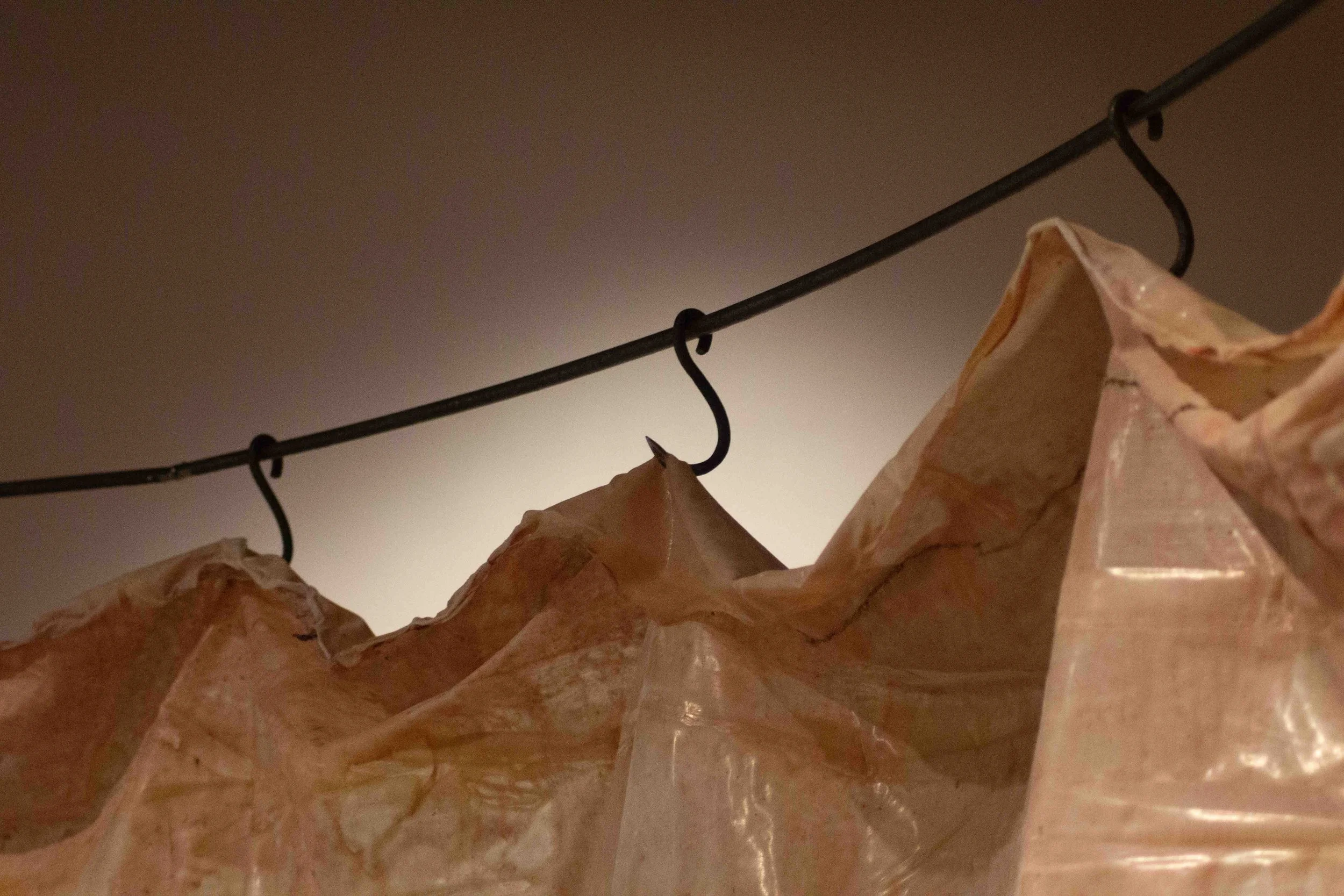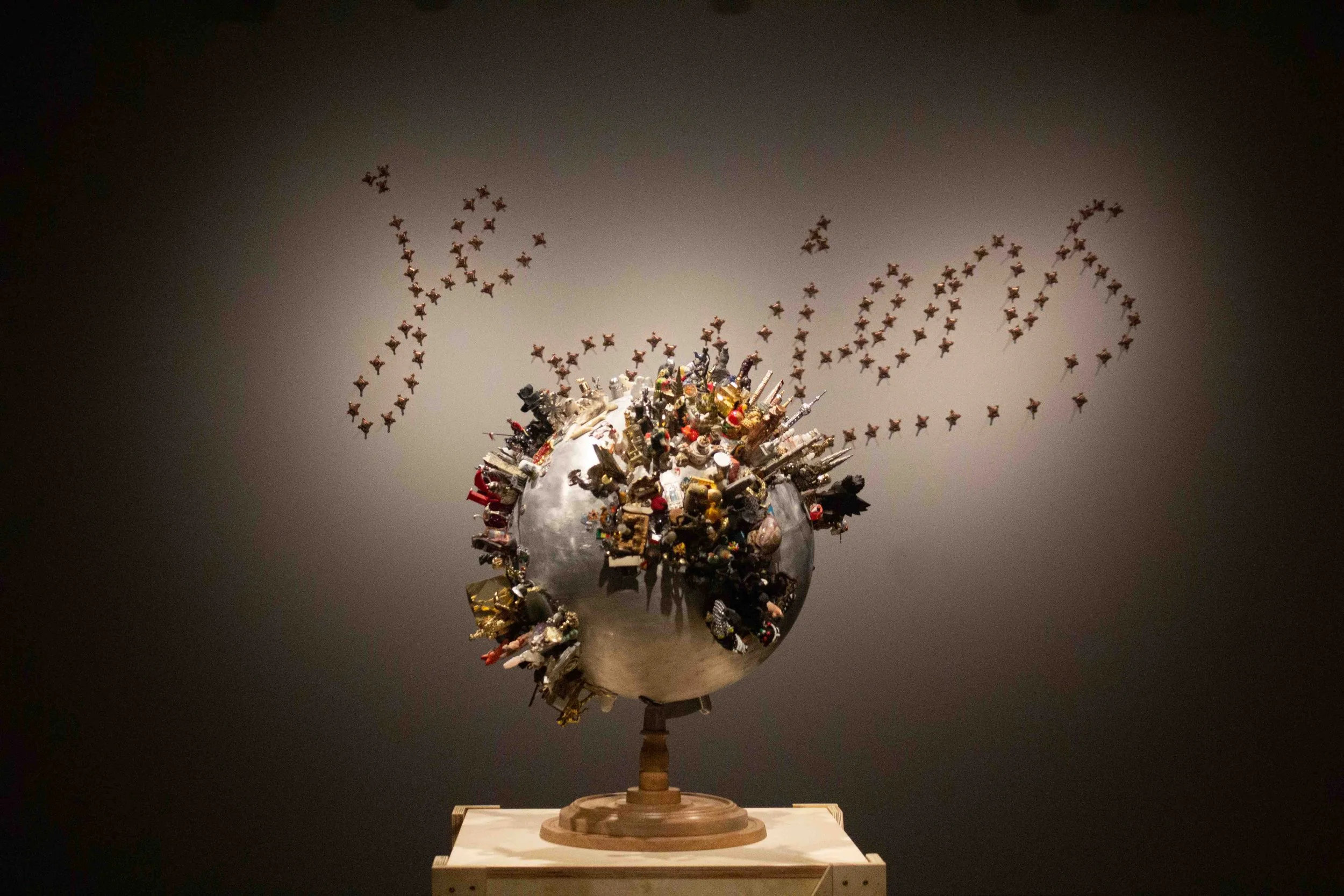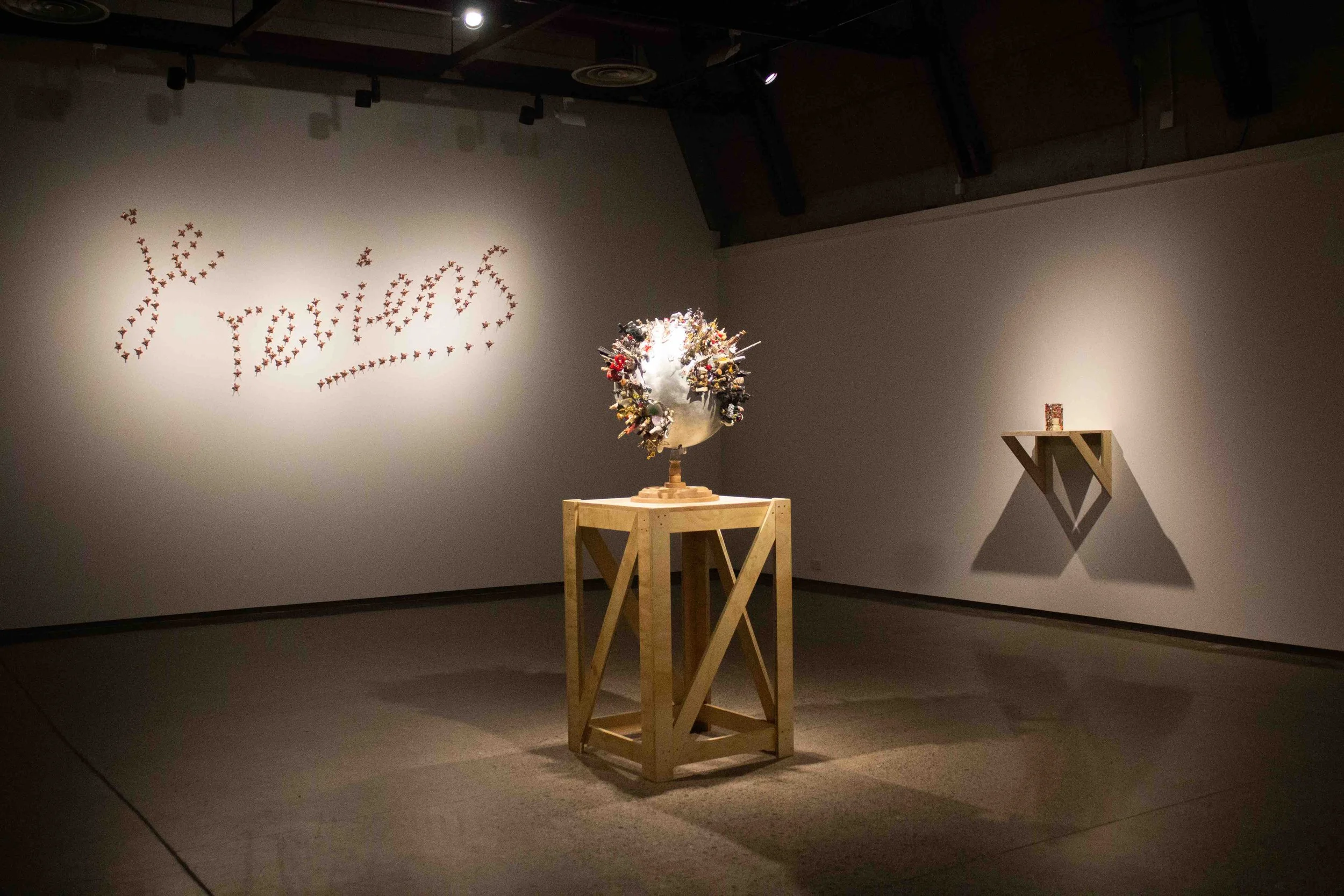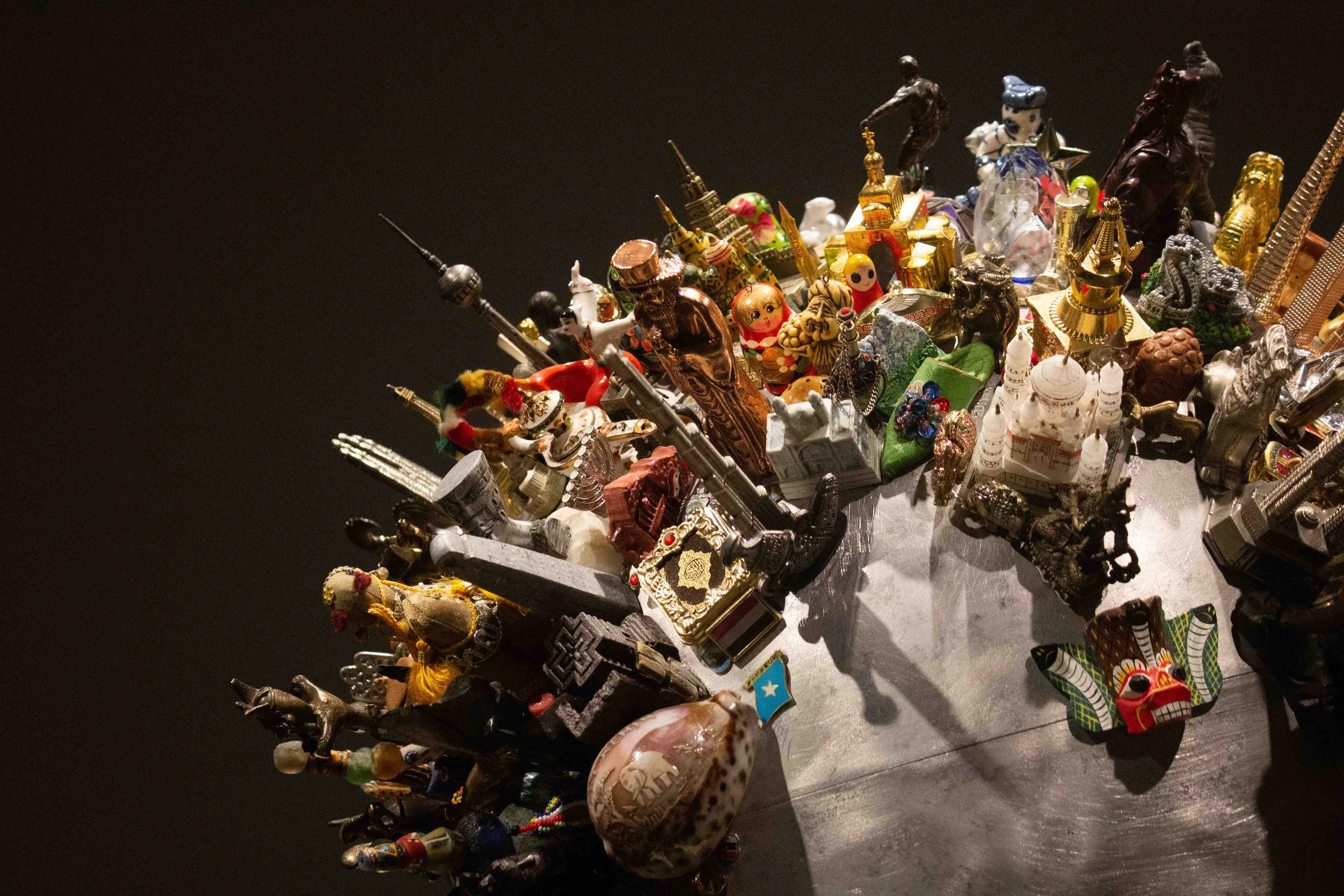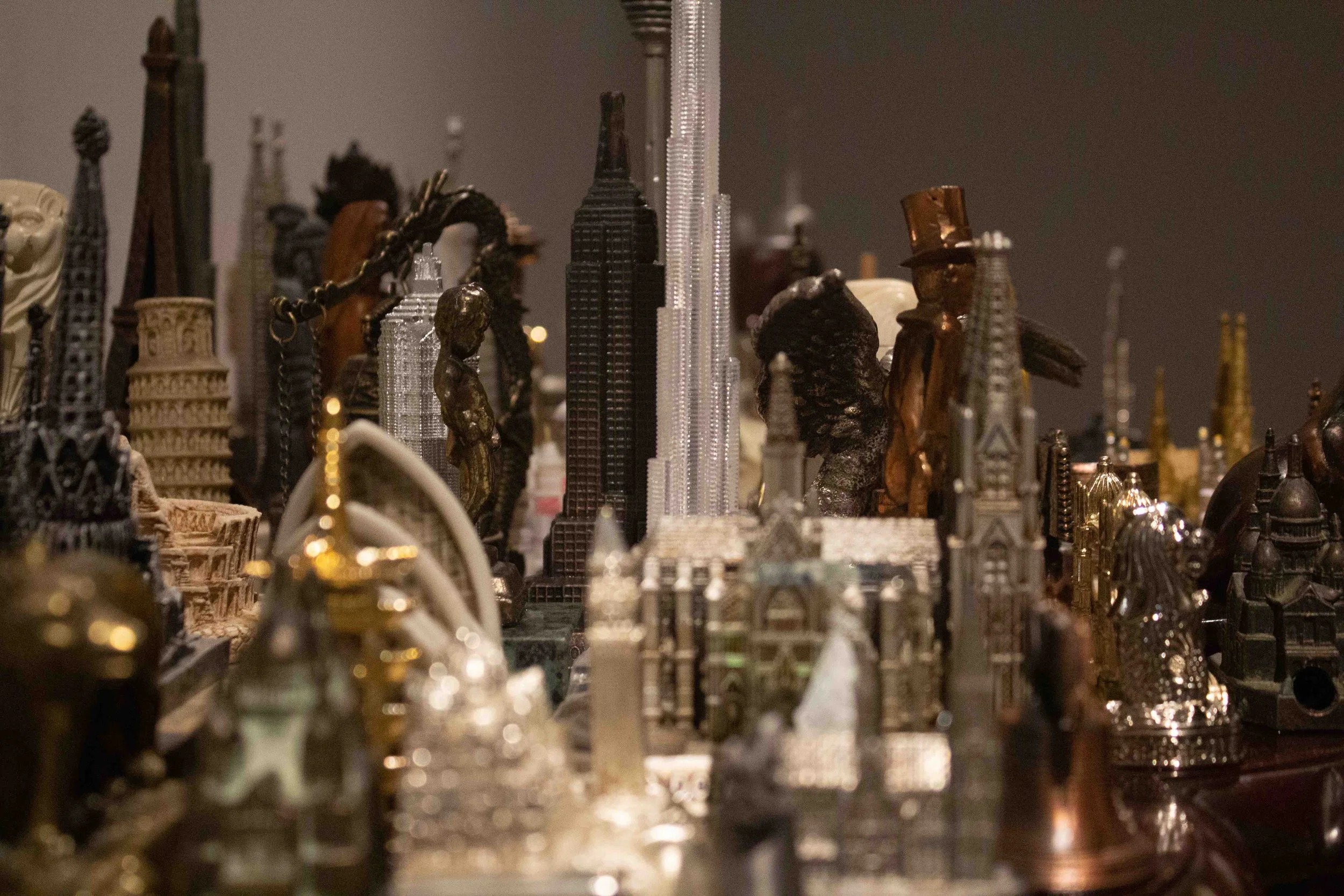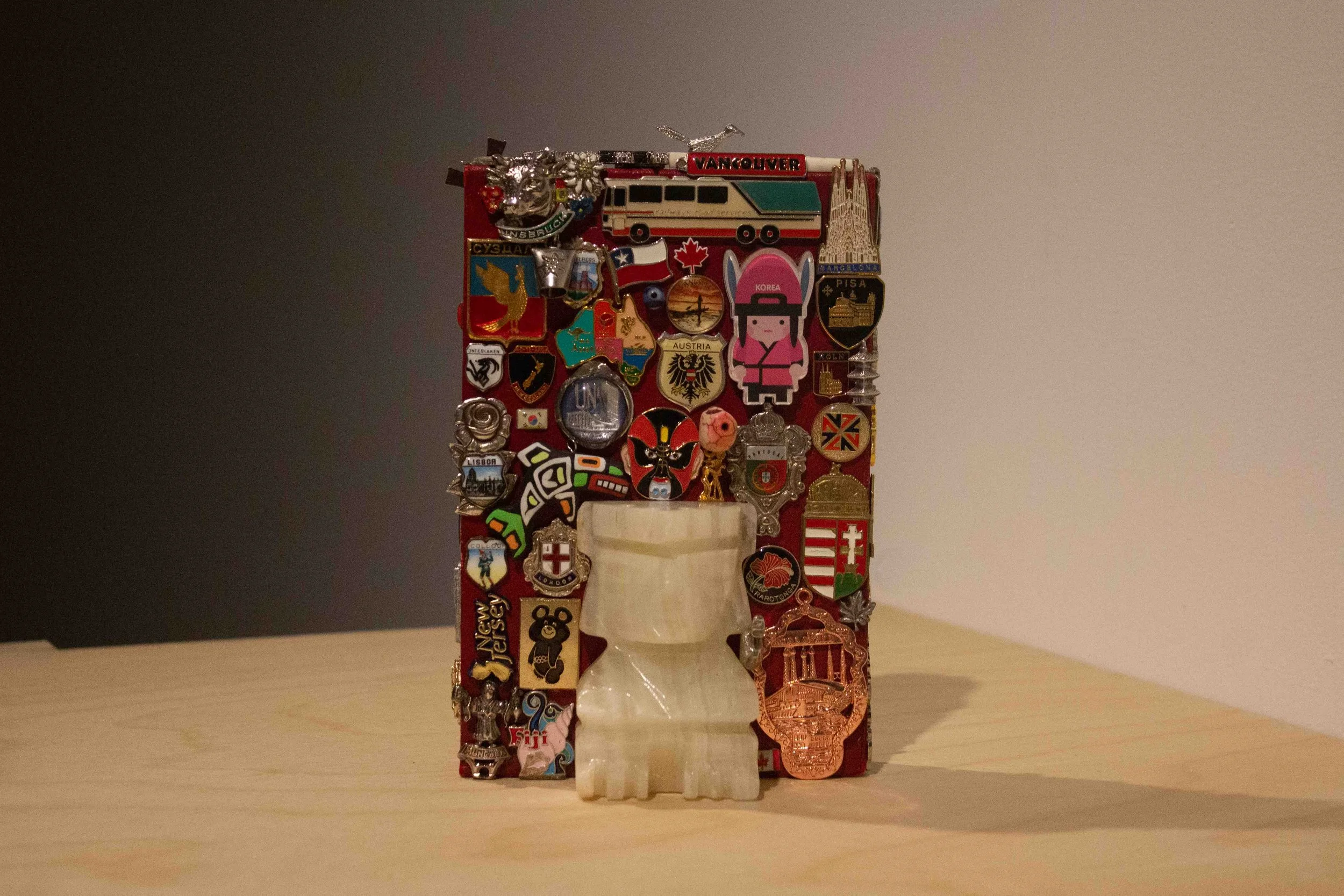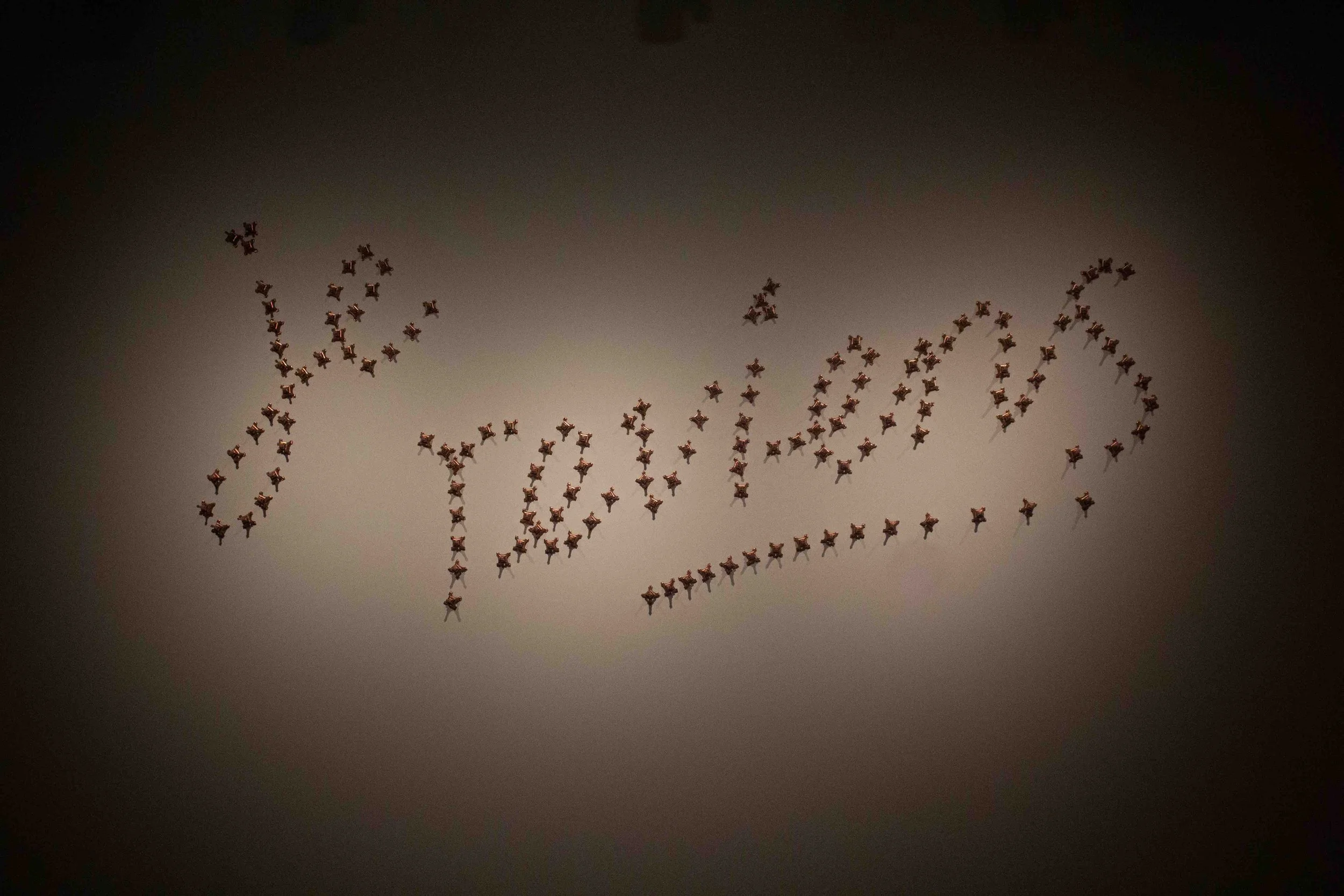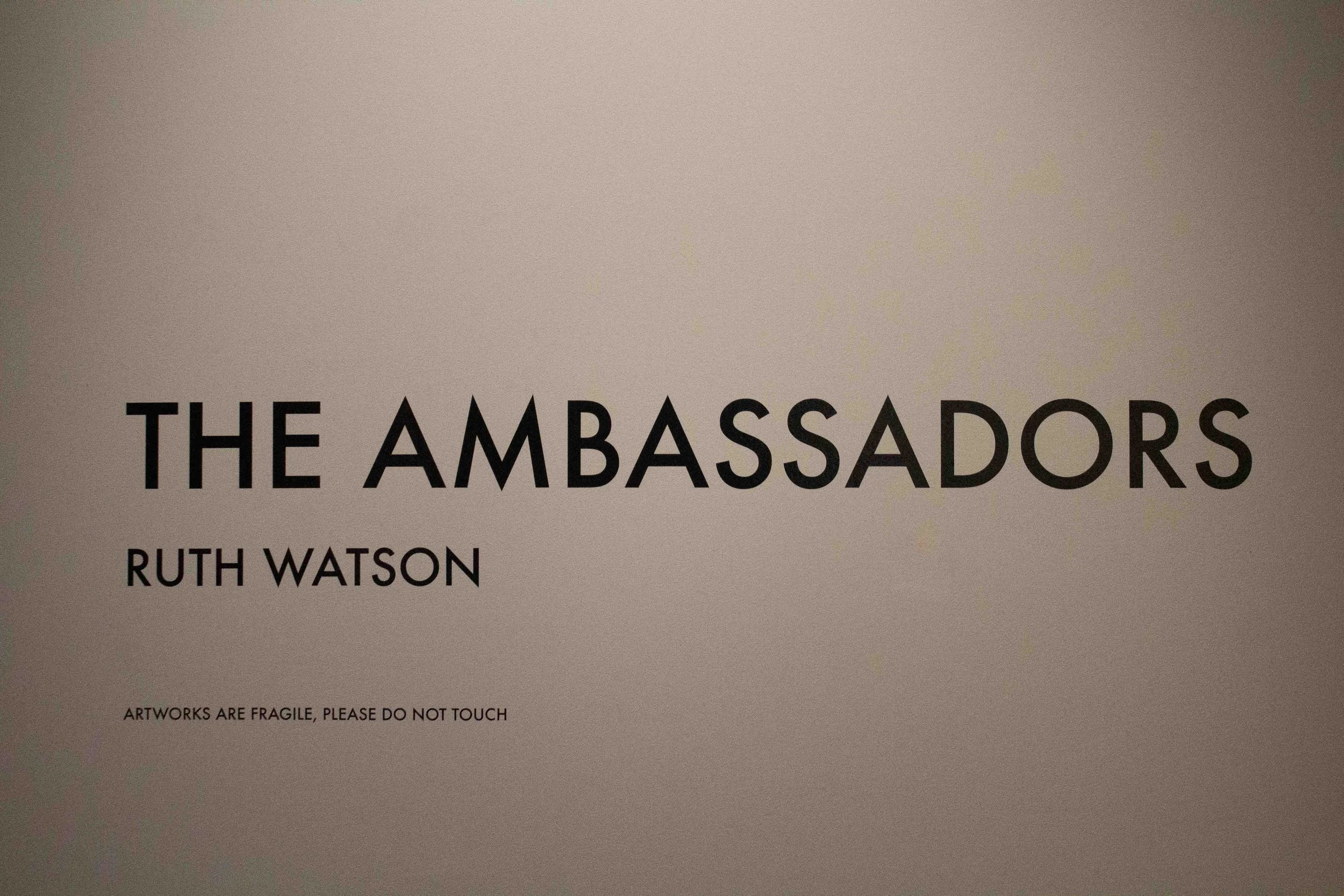Amanda Newall
Disparate Threads – With Fanny Buss And The Three Bears
An exhibition by artist Amanda Newall that weaves together threads both literal and imagined across a wide range of media including textiles, costumes, a carpet, drawings, video and family photographs. Disparate and tenuous on the surface this exhibition is linked through uncanny and rhizomatic threads.
The exhibition showcased work produced during Newall’s Olivia Spencer Bower Award (2022) and featured her three up-scaled ‘matriarchal bears', which function as sculptures and wearable costumes. The bears are based on original children’s toys given to Newall and family members by their maternal grandmother. Family, ancestors, site, costume and embodiment are core thematic elements. In Disparate Threads Newall uses pattern making as a device to consider intangible relationships with family lineage and our artistic ancestors.
During the Olivia Spencer Bower award, Newall found and purchased a Fanny Buss dress in a second-hand store in Auckland. This chance encounter became the inspiration for a new self-portrait on carpet, that considers Newall’s connections to Christchurch, and her life-long interest in costume and its intersections with art.
Just Visiting - Postcards from the Motherland
Malene Laugesen / Moana Lee / Jillian Wordsworth
The idea of ‘going home’ and ‘just visiting’ appear at first to be a contradiction of terms, and yet for these artists, the distinction is blurred. The ‘home’ they desire to visit is no longer home, and yet the connection is so richly aligned to their identity. The Motherland is not so much a physical place but a metaphorical space, existing at times only in memory and imagination. It is a place of nourishment, both physical and spiritual. A prevailing masculine culture would attempt to assert the significance of the male role as patriarch and provider, yet it is our mother who in so many ways gives us both our roots and our wings.
Just Visiting - Postcards from the Motherland is a collaboration between Malene Laugesen, Moana Lee, and Jillian Wordsworth, all working in the Masters programme at the Ilam School of Fine Arts. Through conversations they have discovered significant overlaps between their individual areas of research, with each exploring ideas related to identity, origin, and belonging. Each artists touches on their place in Aotearoa and the inherent tensions that arise from links to shores beyond.
Womancore
Meg Stickings
Womancore is an ode to the woman, to encourage and empower every woman to break free from the control of societal pressures and value herself beyond what society expects of her.
No Offence...But?
Charlotte Dowle / Bailie Piebenga / Hazel White
This exhibition parodies the Ilam School of Fine Arts lecturers' artworks, questioning:
Who determines the value of artworks?
What are the influences and restrictions of the Ilam School of Fine Arts?
Is Trevor the real Aaron Kreisler?
What kind of art is the institution really facilitating?
You can see an end in the fields, and I was about as muddy as I'd ever been, should it be that I leave this place then I would
Sam Neal / Sam Quinn / Eli Molloy-Wolt
Winter
Kettle boiled, tea poured, I left with a canvas sack. A friend swung by and picked me up. He'd take me as far as he could, then I'd hitchhike the rest. Cheek pressed against the glass, spotting fleecy masses perched on hills, sulking, rolling away, leaving their muddy tracks.
9:15. The car's fan is broken, warmed by our breath, watching white build on the windscreen. We hop out and pour my thermos on the ice, the lemon and ginger steam rising. He drops me at the nearest bus shelter, 84 kilometres from home, and traveling west. Slumped under the tin, drifting off in the daytime glare.
Catching number three, sitting up the front, back seats empty. Night nears, illuminating the chintz curtains of a distant window. Cold glooming, the wind blows through the bus door, bitter, biting.
It’s Sunday.
Walking on the motorway, tussocks twitching, roadside hills covered with gorse, the rata rustling overhead. A tarp hangs from a barrier, bundled, moss-laden. Dotted stone walls lead to town, a morning mass in floral church wear, stagnant shop front decorations, Christmas in June.
From the sea wall, I see children play with winter water, gumboots, raincoats, ushering mothers. Basalt gleaming under the fog, bonfire burning in a haze that dances. And I sit solemnly as the wild lupins that grew, clamber, fading. The children leave, their gumboots lay printed upon damp stone, and I wait on a weathered bench, my home for a while.
Watching the burnt hills soften.
Soft
Johanna van der Linden / Fritha Powell
A distinction exists between soft and hard. Sheer fabric, transparent latex, forged steel and cast concrete demonstrate a purposeful juxtaposition of material ecologies. Ethereal materials sited alongside the heavy and sharp.
Soft integrates itself as a feminine interjection into a space of institutional composition and rigidity. Made in situ the large-scale works insert themselves into the hard architecture of the gallery. As both artists explore the dualisms in Catholicism and Architecture; that which is brutal and sacred.
Soft contains installation and sculpture works from Johanna van der Linden and Fritha Powell, two Post Graduate Ilam School of Fine Arts students pushing the scale and boundaries of their individual practices. Soft and hard, hard and soft.
Ruth Watson
The Ambassadors
We’ve all had little souvenirs at some time, whether bought or gifted. Wherever they come from, some of them we love, some of them make us cringe. They raise some questions, one being do they do their job, of reminding us of a time, place or event? It’s a big ask for small, cheap trinkets – coated plastics, low grade metals, painted resin, and so on. Some people turn their noses up at these and prefer more sophisticated fare, or resist their charms for right minded ecological reasons. As for local populations, we mostly disdain the representations of our own places that others buy.
Comprising new works, Ruth Watson’s first solo show in Christchurch for over a decade uses thousands of souvenirs to explore ideas about place, memory, and cultural representation.
Mark Braunias / Brenda Nightingale
Pedagogical Lobster
The Pedagogical Lobster unites two artists whose association has predominantly been formed through art educational context and histories. Mark Braunias and Brenda Nightingale are both ex-art teachers and also alumni of Ilam School of Art albeit from different decades. They now return to the institution as visual practitioners to present their own recent artistic investigations to a new generation of students.
The over-riding premise of this exhibition is to mash together multitudinous works on paper that subvert ideas about drawing in relation to painting. These artists tease out that blurred boundary between the two processes by drawing almost exclusively with paint itself. Are these studies for more ‘finished’ paintings or are they finished as presented? Are they drawing? Are they painting? The viewer is invited to draw their own conclusions. The metaphorical lobster submerged in watery paint fluids with all arms, legs and claws extended awaits in eager anticipation.
Andrew Bond / Kara Burrowes / Charrette van Eekelen
Return to Eden
The notion of ‘Eden’ instinctively alludes to some sort of Utopia or landscape paradise; a place without sin. The interpretation of a personal Eden, echoes an individual intimacy based on life experiences and memory, alongside imagination and fantasy. Each person has within them some degree of absence or longing for a non-existent Arcadia.
The exhibition A Return to Eden rather than looking to a perfect, unattainable fantasy-land, is about spirituality and the contentment of being able to do what each artist intuitively loves. The practice of each artist and the culminating body of works, is a free expression of very different artistic processes and methodologies. Each having a varied life experience and world view, but on a closer inspection areas of osmosis can be witnessed; trails and traces of technique, hue and materials and subtle influencing. Loose connections underpin, but these are tenuous and more than likely; coincidence. Ultimately, each series of works harbours few similarities and three very personal bodies of work have been produced.
